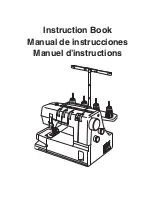
GB
The squeegee does not clean or suck
well
• the edge of the rubber blades in contact
with the floor is rounded off
• replace the rubber blade
• there is an obstruction or damage in the
squeegee or in the tube
• remove the obstruction and repair the
damage
• the float has intervened (recovery tank
full), or is blocked by dirt or broken
• empty the recovery tank or make the
necessary repairs to the float
• there is an obstruction in the suction tube
• free the tube from the obstruction
• the suction tube is not connected to the
squeegee or is damaged
• connect or repair the tube
• the suction unit motor is not fed or is faulty • check that the motor power supply con-
nector is connected to the main wiring in
the right way and that the protection fuse
has not blown; in the second case repla-
ce the motor
Outflow of detergent water from head
is not uniform
• water outlet holes are obstructed
• clean holes
The drive is not working
• the power fuse FU1 and/or the control fuse
FU5 have blown
• check and remove the causes that
made the fuse blow, then replace it
• the thermal protection of the drive motor
has tripped: the motor has become overhe-
ated
• stop the machine and switch it off, let
-
ting it cool down for at least 45’
• the potentiometer is faulty
• replace it
• the anti-crushing microswitch is out of cali-
bration or faulty (the machine does not work
in reverse);
• calibrate or replace
• the parking brake is engaged
• release the brake
• check the components (drive motor, drive
control unit, connectors)
• have the faulty component replaced
The washing head does not go down
• the fuse FU5 has blown
• check and remove the causes that
made the fuse blow, then replace it
• the head descent actuator is disconnected
or broken
• have the connection restored or the ac-
tuator replaced
The batteries do not ensure the nor-
mal work time
• the poles and charging clips of the batteri-
es are dirty and oxydized
• clean and grease the poles and clips,
recharge the batteries
• the electrolyte level is low
• add distilled water topping up all ele-
ments according to the instructions
• the battery-charger does not work or is
unsuitable
• see instructions relative to the battery-
charger
• there are considerable differences in den-
sity between the various elements of the
battery
• replace the damaged battery
• the machine is working with a too high
pressure on the brush
• reduce pressure on the brush
The storage battery gets flat too fast
during use, although it has been
charged in the correct way and when
tested with a densimeter at the end
of recharging, it turned out to be uni
-
formly charged
• the storage battery is new and does not
give 100% of its expected capacity
• it is necessary to “run-in” the storage
battery by 20-30 charges and discharges
to obtain maximum performance
• the machine is used at its maximum ca-
pacity for continuous periods and the auto-
nomy is not sufficient
• use, if possible, storage batteries with
larger capacity or replace the storage
batteries with others already charged
• the electrolyte has evaporated and does
not cover the plates completely
• add distilled water, topping up all ele
-
ments until the plates are covered and
recharge the storage battery
The storage battery gets flat too fast
during use, the recharging with an
electronic battery-charger is too fast
and at the end the storage battery gi-
ves the right voltage (about 2,14V for
each empty element), but it turns out
to be not uniformly charged when te-
sted with densimeter
• the storage battery, already filled with acid
by the Manufacturer, has been stored for a
too long time before being recharged and
used for the first time
• if the recharging with a normal storage-
charger is not effective, it is necessary to
carry out a double recharging consisting
in:
- a slow recharging of about 10 hours
with a current equal to 1/10 of the rated
capacity expressed in 5 hours (ex.: for a
storage battery of 100Ah(5), the current
should be 10A, realized by a manual
battery-charger);
- one-hour pause;
- charging with a normal battery-charger
31
Содержание CT105 BT70 Traction
Страница 2: ...GB ENGLISH Translation of original instructions 2...
Страница 6: ...GB X Y Z See TECHNICAL SPECIFICATIONS table MACHINE DIMENSIONS X Z Y 6...
Страница 8: ...GB Figure 1 8 A B C 1 2 4 5 3 6 7 2 3 4 8...
Страница 10: ...GB 11 13 14 15 16 12 OK NO 1 3 2 OFF ON 1 1 5 2 3 4 1 2 3 2 5 5 2 2 4 3 3 F U 6 F U 7 F U 8 10...
Страница 11: ...GB F U 6 F U 7 F U 8 17 19 18 4 1 5 2 3 7 1 2 8 8 7 6 5 4 3 3 20 21 22 1 1 1 FU1 FU4 FU5 11...
Страница 33: ...GB 33...
Страница 34: ...GB 34...
Страница 35: ...GB 35...







































